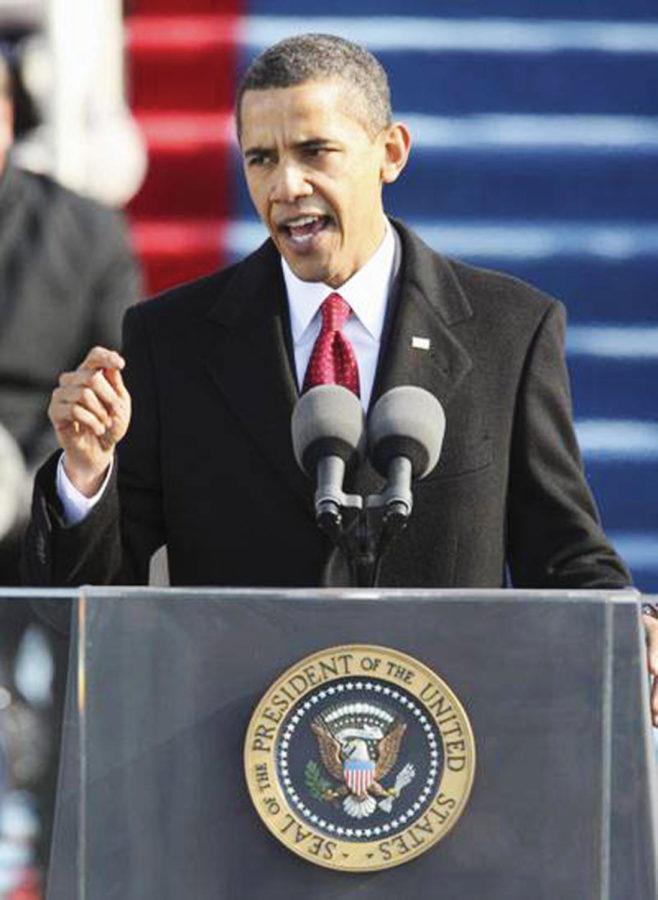Godfrey: Riding Solo on Climate Change
Photo courtesy of Associated Press/Ron Edmunds
President Barack Obama gives his inaugural address at the U.S. Capitol in Washington, D.C., on Tues., Jan. 20, 2009.
February 28, 2013
During the first State of the Union address of his second term, President Barack Obama set some ambitious humanitarian goals, which included achieving an AIDS-free generation, establishing universal preschool and raising the minimum wage, to name a few. But of the issues he mentioned, none were more urgent than his plan for combating climate change — or at least, his notion to combat climate change.
Indeed, there was no plan spelled-out for the American people as to how, exactly, our government will come together to save our warming Earth. But in reality, there didn’t need to be. Climate change has become the song on the radio people have heard too many times — the can kicked down the road far too long. Some Americans may believe global warming exists, but have become numb to it; they certainly don’t comprehend its urgency.
If the president is going to act against climate change, he will be doing it alone — at least in the beginning. And he knows it.
In his speech, Obama advocated for bipartisanship surrounding the issue of climate change, but he seemed already resigned to the fact that collaboration might not work out so well.
“…if Congress won’t act soon to protect future generations,” Obama said with a grim smile, “I will.”
Obama plans to take executive action to reduce pollution, prepare for the future consequences of climate change and ease the transition to sustainable energy for the long-term. Clean energy is at hand, but words mean nothing without action, unilateral or otherwise. What can the president do right now?
There are several existing authorities the White House needs to expand on if they expect to make any progress, starting with the EPA. At the Copenhagen summit in 2009, Obama pledged to reduce greenhouse gas emissions 17 percent below 2005 levels by the year 2020. The combination of recession, tightly enforced regulatory standards in some more ‘green’ states and, most importantly, strong EPA action, have all made this goal within our reach. But he can do more.
According to the EPA, more than two-thirds of the nation’s greenhouse gas emissions came from power plants. The solution? The Clean Air Act of 1990. After establishing the carbon limit for our nation’s power plants, the EPA needs to actually begin enforcing this act in order to significantly reduce carbon emissions and use new technology to restructure our nation’s most antique power plants.
Additionally, the EPA already enforces regulations encouraging autoworkers to create a new line of vehicles able to reach 54.5 miles per gallon by 2020; a point touched on briefly by Obama in his speech. This will reduce the country’s carbon emissions from transportation, which happens to be America’s second-highest contributor of greenhouse gases.
In a recent interview with BuzzFeed, Florida Sen. Marco Rubio responded to a question about the effects of global warming, saying he was doubtful working to reduce our own greenhouse gas emissions would make a difference, as long as China and India, two of the largest contributors to global climate change, did nothing.
And although Rubio foolishly denies the confirmed existence of climate change, in humoring his interviewer, he presents a valid point: there will be no progress unless the largest contributors to the climate crisis — China, India, the European Union and the United States — work harder to advocate for the environment.
That brings us to the next project the president could take on all by himself, and perhaps the one that makes the most sense. He can start the talks with China.
Without Congress, Obama, along with Secretary of State John Kerry, need to engage in diplomatic climate talks with China, with the sole purpose being to cement an agreement on reducing carbon pollution and switching to alternative energy. Once major polluters are on the same page, our planet will face a cleaner future, and its people will be that much more informed and united to protect the earth from this man-made crisis.
All of these are approaches Obama will have to undertake if he truly means to keep his promise to protect our planet from the looming threat of climate change — no matter who’s with him. But what we should certainly expect from our president is further dialogue. Obama will have to make special use of his “bully pulpit” by starting the climate change conversation with the American people right now. He must end the broken-record climate talk and begin anew, by explaining the reality and urgency of climate change, conceivably the greatest challenge our generation will ever face.
Whether he will is a different story.
——————————————————————————————-
Elaine Godfrey is a sophomore in journalism and mass communication and global resource systems from Burlington, Iowa.







